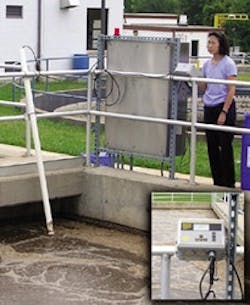Optical DO Sensors Improve Microbial Efficiency at Wastewater Treatment Plants
Dissolved oxygen (DO) monitoring in wastewater is critical for efficient operation of wastewater treatment plants. Continuous and reliable DO monitoring can improve plant efficiency, which lowers operating costs, and also decreases the risk of unwanted odors.
While DO sensors have been available for decades, new optical sensor technology offers significant improvements to the reliability of DO measurements, especially in the low-oxygen environments found in wastewater treatment processes. The new technology also lends itself to improved real-time monitoring and automated control.
Aeration monitoring & control in Ohio
A wastewater treatment plant in Ohio was interested in determining the efficiency of its treatment process. To help facilitate this evaluation, a YSI 600 OMS sonde—containing a YSI ROX™ (Reliable Oxygen) optical DO sensor —was installed in the harsh environment of the mixed-liquor wastewater basin to continuously collect DO data.
In a typical biological treatment process, wastewater is transferred to aeration basins after it has been screened to remove large solids. Dissolved oxygen can be monitored in the basins to optimize and, in some cases, control oxygen addition to stimulate aerobic microorganisms. These organisms turn the remaining organic wastes into inorganic byproducts before the treated water is safely released back into the streams of rural Ohio.
Dissolved oxygen concentrations that are too low during treatment can negatively affect the microorganisms, while high DO concentrations result in higher energy costs and the promotion of unwanted microorganisms. The costs associated with aeration in this secondary stage of treatment can typically run 50% or more of the total power use of a treatment facility. Therefore, reliable and continuous monitoring of DO could help wastewater treatment plants save money by aerating only when necessary.
Data were transmitted from the 600OMS sonde via cabling to a YSI 6500 Environmental Process Monitor using SDI-12 protocol. The Environmental Process Monitor is in a watertight enclosure, and it has four relays that can drive alarm indicators, such as lamps, horns or automatic phone dialer systems, to indicate dangerously low or high DO concentrations.
For future upgrades, the Ohio plant could automate aeration control by interfacing the 6500’s 4-20 mA output into the plant’s SCADA system and establishing upper and lower control criteria, further improving plant efficiencies and lowering the risk of out-of-range oxygen episodes.
The plant operators were most interested in the optical technology, as it compared to traditional polarographic sensor technology. Initial results from the DO monitoring (Figure 1) indicate that the ROX sensor is providing accurate data with minimal sensor drift (43 days and counting). The sensor also requires less maintenance because it does not have a membrane and does not require electrolyte solutions.
Monitoring settling ponds in California
A wastewater treatment plant in Sacramento, Calif., is dealing with population growth projections that will affect the 165 million gal of wastewater being processed daily. Currently, the regional sanitation district has an aggressive 20-year master plan to deal with the growth, address changes in regulatory compliance, and review emerging technologies used in wastewater treatment.
In its treatment process, the Sacramento plant uses settling ponds to treat sludge. Settling ponds are unique environments where anaerobic bacteria break down sludge, while aerobic algae near the surface break down the bacterial byproducts, such as odor-causing hydrogen sulfide. This creates a dynamic DO environment and challenging conditions for in situ water quality monitors.
Plant technicians work diligently to maintain the oxygen-rich upper layers of the water column in order to prevent odor-causing gases from escaping and affecting the local environment. Continuous monitoring of DO in settling ponds allows them to respond quickly when dangerously low oxygen levels are measured. They can then take preventive actions such as aeration or dilution with freshwater to restore the oxygen levels to normal.
In the past, the main challenges with DO monitoring in settling ponds have been:
- The presence of hydrogen sulfide gas, which quickly corrodes the electrodes of traditional polarographic (Clark-type) DO sensors; and
- Aggressive biofouling found in settling ponds.
The ROX sensor addressed these challenges because it is insensitive to hydrogen sulfide and has an integrated anti-fouling wiper to prevent organism growth on the sensor, thus prolonging the length of time an instrument can be deployed and take accurate measurements./p>
Continuous data, longer deployment times, and less frequent visits by technicians to inspect the equipment justifies the cost of ownership of optical sensor technology for the regional sanitation district./p>
Conclusions about optical DO monitoring technology
Sewage and wastewater monitoring is a tough environment to manage. For biological processes to work efficiently, continuous monitoring of the slightest changes in DO is critical. The Ohio and Sacramento wastewater treatment plants have been able to successfully monitor their DO levels with YSI’s wide-range (0 to 500%) ROX optical sensor./p>
An ROX sensor plugged into a YSI multiparameter sonde and combined with the YSI 6500 Environmental Process Monitor creates a powerful and reliable system to continuously monitor DO, conductivity, pH/ORP and temperature throughout the wastewater treatment process. /p>
Additional capabilities include automated aeration control, alarm triggers, and integration into existing SCADA systems. Finally, the YSI system for deploying multiparameter instruments in PVC pipe makes it easy, relative to most competitive products, to remove the sonde from the water for any required maintenance.
